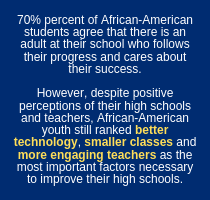Two years ago, the United Negro College Fund (UNCF) began the first of many conversations with nearly 800 African-American students in several cities to learn what improvements they felt were necessary to make their educational experiences better. Those conversations evolved into an honest and candid dialogue, which resulted in a few surprising suggestions.
Some of the students applauded their teachers and schools with stories of how they felt their teachers have prepared them for college. They called out specific teachers and/or administrators who followed their progress and showed concern for the students’ success.
Other stories were more difficult to digest. For example, over one-third of students in the study felt their race could limit their opportunities in life, and only 43% felt that their schools were safe—citing daily trips to school that involved the threat of gang intimidation and unsafe drivers.
Detailed findings of this study are examined in the UNCF report A Seat at the Table: African American Youth’s Perceptions of K-12 Education. In it, students are clear about the top three factors needed to improve their high school experience:
- Better Technology
- Smaller Class Sizes
- More Engaging Teachers
Factor #3. Better Technology Resources
It’s a common misconception that access to technology or the internet is no longer an issue because, “Wi-fi is everywhere, right?” In fact, there are school districts that do not have the resources to provide students with the most up-to-date technology. This is what widens the achievement and homework gaps.
The main concern is how students in low-income districts are learning without access to 21st-century education technology resources. How do we ensure that access to education technology is being provided to schools with the most need? And, as more teachers increase their use of technology in their daily lesson plans and homework assignments, what happens to those students who don’t have the required tech tools to keep up?
Access to education technology goes beyond ensuring that students have internet access and a computer. Access must also include availability of digital-learning tools, digital content, and teachers who are well-trained on using and teaching with technology. Years ago, when I was a classroom teacher, we taught students the fundamentals of technology before introducing them to the actual tech tools. Now, the approach is to use technology for learning simultaneously.
While technology is not the cure-all to academic success, it is essential to 21st-century learning and successfully implementing new online state academic assessments. Per pupil spending in the U.S. can range from $6,500 to $20,000, with high-minority, high-poverty schools generally falling on the low end of the spectrum. This is yet more evidence of the difficulty in improving technology in these at-risk schools.
Factor #2: Smaller Class Sizes for More One-on-One Attention
“I feel like in a classroom that isn’t crowded, you get a chance to be in touch with everybody,” said a 14-year old in the UNCF study.
This statement backs up studies that consistently show the benefits of small class environments. In a classroom that isn’t “crowded,” learning is enhanced, more ideas are shared, and student academic performance is greater.
And students are hungry for more opportunities to learn! Over 66% of African-American youth indicated that success in school was their most important priority among other competing factors, and research suggests that youth who are more engaged and more optimistic about education are more likely to aspire to attend college. Smaller class sizes could be the key to higher graduation rates and college attendance rates among this population.
Smaller class sizes also see a reduced number of disciplinary incidents. This is particularly important as nearly half of African-American youth reported they experienced some form of discipline in school (in and out-of-school suspension or expulsion), which decreased their quality time in the classroom.
The African-American students in the study recognized the need for one-on-one attention from their teachers and felt that having additional time with teachers in a more intimate environment would help them succeed academically.
Factor #1: Schools Need More Engaging Teachers
We often hear that quality education begins with quality teachers. So, think back to when you were in elementary, middle or high school. Who were your favorite teachers? Maybe it was a P.E. teacher, your fourth-grade science teacher or your homeroom teacher.
Now, think about why they were your favorite teacher. What made being in their class stand out in your mind, even now? I bet they engaged you in learning. Perhaps they adopted active learning into their instruction. Maybe they turned an incredibly boring subject into something interesting and exciting. Or, maybe their interest in you and your academic progress felt genuine.
Our study showed that today, there is a disparity in the student-teacher experience. Students shared that that their K-12 experience would be better if they had more engaged teachers in their classrooms.
The declining numbers of qualified teachers is a nationwide crisis. And African-American students are often located in schools with less qualified teachers, and teachers with lower salaries. While research supports the overwhelming benefit of teachers of color, the need to recruit and retain qualified minority teachers needs significant attention as well.
The hard truth is, African-American kids who attend schools in low-income communities recognize that many of their teachers are not engaging them in a way that is conducive to their academic success. This unfortunate reality was confirmed in the answers given by the students in the UNCF study, who ranked the quality of classroom as the number one factor to improve education.

This shows how desperately we need to enhance professional development for teachers, raise teaching standards, and hire more diverse teachers to help close achievement gaps for students of color.
The Path to a Brighter Future
While parents, educators, administrators and policymakers have debated, proposed and implemented profound strategies for school improvement, hearing what students think lights our path to giving them the tools they need to succeed in school and in life. To get there, everyone needs a seat at the table because inclusivity is empowering. When all voices are heard, it helps ensure that the changes we make to meet our students’ needs are effective and lasting for their success.
Sekou Biddle, is Vice President for K-12 Advocacy at UNCF. He is a full-time dad and has 20 years of experience in urban public education reform and local government and was a classroom teacher.





